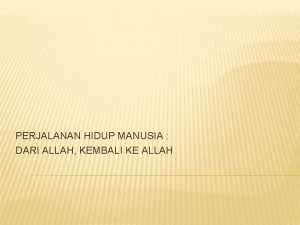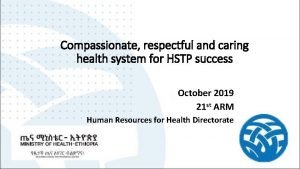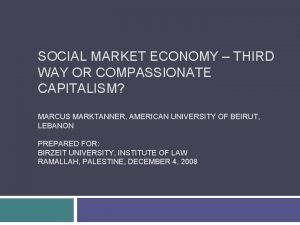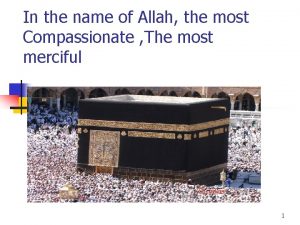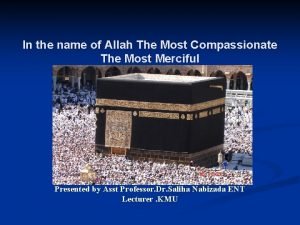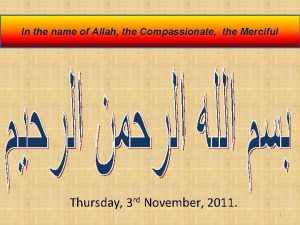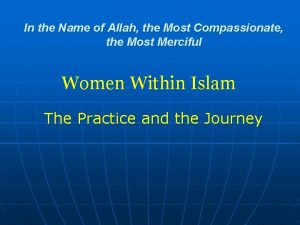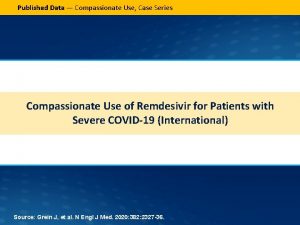In the name of Allah Passed the compassionate




















- Slides: 20

ﺑﺴﻢ ﺍﻟﻠﻪ ﺍﻟﺮﺣﻤﺎﻥ ﺍﻟﺮﺣیﻢ In the name of Allah Passed the compassionate the merciful

Iranian National Institute for Oceanography and Atmospheric Science Fatty acids and Nutritional Components of Ulva Fasciata macroalgae from Qeshm Island, the Northern Persian Gulf Homira Agah Ph. D in Analytical and Environmental Chemistry Ass. Prof. in Iranian National Institute for Oceanography and Atmospheric Sciences Co-Workers: Irandoust F. 2, Costantini M. Letizia 2, Rohi F. , Savari Sh. 2 University Sapienza of Rome, Department of Environmental Biology 2016

v Increasing world population intensifies the need for access to qualified cheap food. Ø Marine resources is one of the best sources that human can access to that.

v Algae is an important marine organisms. v In addition to ecological importance, algae have different industrial, agricultural, pharmaceutical and also nutritional applications, due to their valuable compounds. Such as: Lipids (essential fatty acids), carbohydrates (Energy provider), nutrients, phenols, Amino acids, Fibers, different vitamins, essential elements (minerals), and protein, which makes them appropriate feeding source. ( Jensen, 1993) (Bligh and Dyer , 1959) (Richinond, 1990; Becker, 1994 and Caugliey et a. I. , 1996).

Estimating algal economical benefits v It is estimated that algal trade provides 5. 5 – 6 milliard $ per year, of which almost 5 milliard $ is allocated to nutritional applications. v Industrial algae applications per year is about 5. 7 -8 million ton (wet).

v 35 countries from Northern to Southern sphere have algal production. v. According to FAO (2002), 91% of algal productions is allocated to Asia, while 71% of it is belonged to china. Comparing production of Algae in global range v The use of macro algae in Asia as industrial and food source is well known and established. http: //rifr-ac. ir/data/ufiles/29 f 1_. pdf

Hypothesis ü Algae is one of the most important sources to access to valuable fatty acids such as omegas and other compounds.

Object v In Southern parts of Iran the three kinds of algae (green, brown and blue) are plentiful. v Detection algal valuable compounds can elevate local economical level and health of local people.

v. Over than 250 algal species have been recognized at the Northern Persian Gulf with different industrial and feeding applications. v Ulva sp. is one of the 221 macro algal species have been listed worldwide as algae with commercially utilization Ohno, 1999). Ulva Fasciata (Zemke-White &

Algal valuable Compounds v There is limited information about this Ulav Sp. in this region. v According to different geographical situations, seasons, years, temperatures and water salinities, biochemical compounds of algae can differ (Jensen, 1993).

ü Dettected major fatty acid compositions: § to obtain an oil rich in α-linolenic essential fatty acid with a low ω6: ω3 ratio and its nutritional value. ü Biochemical composition of Ulva Fasciata

q The green alga Ulva Fasciata from intertidal zone of the Qeshm Island (Persian Gulf), was manually collected, transported to laboratory on ice and then freeze dried until dryness. Water content was 76. 6± 0. 28 %.

Detection of Fatty Acids in Ulva sp. v 2 gram macro alga was extracted using soxhlet by methanol (6 h) = 3. 6± 0. 6 %. v According to food and livestock feeds industries, diethyl ether solvent, and soxhlet (2 h)= (0. 35% dry weight). ü Chemstation data analysis system was utilized. The final result of triplicate injections was reported. v The main fatty acids were detected by GC/MS equipped with electron impact ionization source under (EI) mode of 70 ev, and quadrupole mass instrument after derivatizing the extracted algal oil. analyzing

The major fatty acids: palmitic acid C 16: 0> Stearic acid C 18: 0> a-linolenic acid C 18: 3> Eicosadienoic acid C 20: 5> Myristic acid C 14: 0> Arachidonic acid C 18: 1 > Nervonic acid C 24: 1 > Oleic acid> Heptadecanoic acid> Pentadecanoic acid. All the data were expressed as dry weight.

v Human body needs fatty acids, a part of them such as Omega 3 unsaturated fatty acid, should be supply through diet or supplements. v In addition to ω− 3, the human body needs omega-6 as well (They compete with each other on the enzymes). v Consumption of omega-3 fatty acids reduces the risk of cancer and heart disease and lowers cholesterol and triglycerides in the blood, lowers blood pressure, …… v(Borowitzka, 1988; Callegari, 1989; Hemikson, 1989; Richinond, 1990 and Rodriguez and Guerrero, 1992).

v The balanced intake of essential fatty acids (ω− 6 /ω− 3) can significantly influence the human health. v Low ω− 6 /ω− 3 ratio to approximately 1 lessens the pathogenesis of many diseases. v. The results exhibit that: 1 - The ratios of ω− 6 /ω− 3<1 in the Ulva sp. extracted lipid. ω− 3 =14. 7 %, ω− 6=2. 4 % of lipid content. 2 - Ulva lipids can be an appropriate nutrition source.

Applications of Ulva sp. in agriculture as fertilizer v Ulva SP. can provide minerals and rare elements. 1. 6 % Ca as macro mineral, 0. 56% P, 4. 98% Mg, 3218 ppm Fe, 4. 9 ppm Cu, 32 ppm Zn, 70. 1 ppm Mn

v As livestock and poultry feed, some chemical compositions such as crude protein (8. 5 %, CP), Crude Fiber (0. 95%, CF), Acid Detergent Fiber (0. 25%, ADF), Neutral Detergent Fiber (16. 9 %, NDF), Gross Energy (1520 cal. , GE) and 38. 9% Ash, were measured (Mc. Dermid & Stuercke, 2003). v Crude Protein (CP) level is dependent on season and environmental growth conditions (Dawczynski et al. , 2007).

v Ulva sp. can be valuable sources for livestock feed supplements. ü Can Lessen virtual water consumption by provender, livestock. v More investigation is necessary to determine exact portion of the algae, which can be added to provender. v Southern parts of Iran with 1800 kilometer coastal areas have various algal bio-diverse resources, which shows the importance of cultivating algae in these areas.

Thank you for your attention Any Question?
 In the name of allah the compassionate the merciful
In the name of allah the compassionate the merciful Allahumma ishfi bi rahmatika bi amrika
Allahumma ishfi bi rahmatika bi amrika Allah the compassionate
Allah the compassionate Perjalanan hidup manusia
Perjalanan hidup manusia Exam office uoa
Exam office uoa Example of compassionate letter to yourself
Example of compassionate letter to yourself Compassionate ottawa
Compassionate ottawa Compassionate respectful and caring
Compassionate respectful and caring The most compassionate
The most compassionate Compassionate capitalism definition
Compassionate capitalism definition Pallatie
Pallatie Draw three noncollinear points j k and l
Draw three noncollinear points j k and l Pengertian asmaul husna secara istilah
Pengertian asmaul husna secara istilah Kedosaan manusia akan mendatangkan
Kedosaan manusia akan mendatangkan Ya sabur
Ya sabur Almighty allah the most merciful
Almighty allah the most merciful In the name of allah the most beneficent the most merciful
In the name of allah the most beneficent the most merciful Ponceau pronunciation
Ponceau pronunciation Guddi baji
Guddi baji Bismillah in the name of allah
Bismillah in the name of allah In the name of allah, the most gracious, the most merciful
In the name of allah, the most gracious, the most merciful



